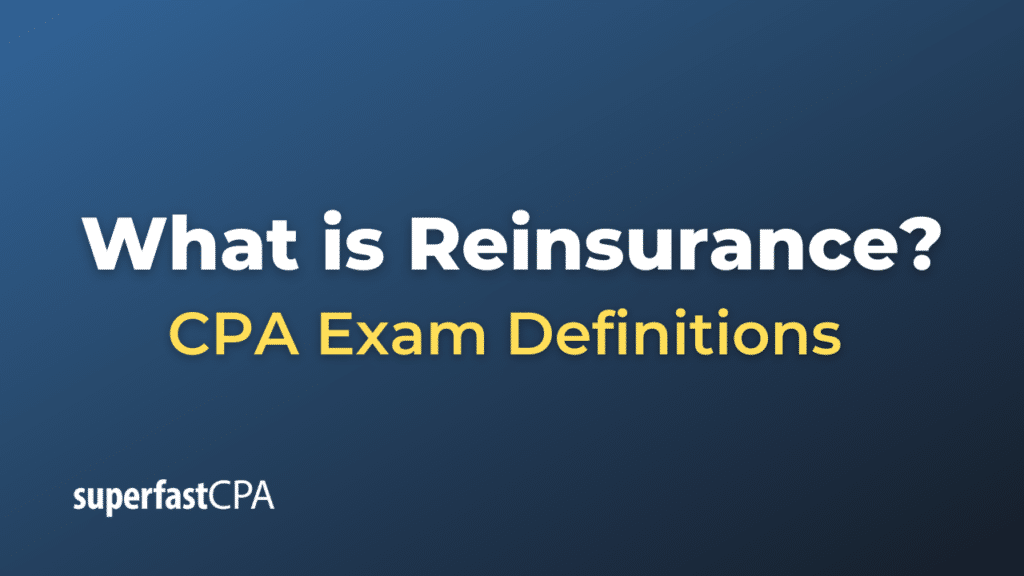Reinsurance
Reinsurance is essentially “insurance for insurance companies.” It’s a practice where an insurance company (the “ceding insurer” or “cedent”) transfers a portion of its risks to another insurance company (the “reinsurer”). The primary objective is to manage exposure to losses, stabilize loss experience, increase capacity, and improve solvency margins.
Here’s why reinsurance is important:
- Risk Transfer: Insurance companies take on significant risks when they issue policies. By purchasing reinsurance, they can transfer some of this risk, ensuring that they won’t be overly exposed if a major claim (or multiple claims) comes in.
- Stabilize Losses : Reinsurance can smooth out the loss experience of an insurer by preventing any single event from causing overly burdensome losses.
- Increase Capacity: An insurance company’s ability to underwrite policies is limited by its capital. Reinsurance allows insurers to write more policies and take on more risk than they otherwise would be able to with their own capital.
- Expertise and Innovation: Sometimes, a ceding insurer may want to offer a new type of policy but might lack the expertise in-house. A reinsurer with experience in that area can provide the necessary know-how.
- Solvency and Financial Stability : Reinsurance can help an insurer maintain solvency following major claims events, ensuring the insurer can meet its obligations to policyholders.
There are different types of reinsurance arrangements:
- Treaty Reinsurance: This is a standing agreement between the ceding insurer and the reinsurer, wherein the reinsurer agrees to cover specified types or categories of risks over a set period.
- Facultative Reinsurance: This is arranged on a case-by-case basis. The ceding insurer can choose which risks to offer to the reinsurer, and the reinsurer can choose whether or not to accept them.
- Proportional Reinsurance: Here, the reinsurer takes on a proportionate share of the risks and rewards. If the ceding insurer has agreed to cede 30% of a particular policy to the reinsurer, then the reinsurer would pay 30% of any claim and receive 30% of the premiums.
- Non-proportional Reinsurance: Also known as “excess of loss” reinsurance, this kicks in only when losses exceed a specified amount. It’s like a deductible for the insurance company.
Reinsurance is a critical component of the global insurance industry, playing a crucial role in its financial health and stability. By spreading risks more broadly, reinsurance helps ensure that the insurance system can handle even large and unexpected losses.
Example of Reinsurance
Let’s delve into a practical example to understand reinsurance better, focusing on a non-proportional reinsurance, also known as “excess of loss” reinsurance.
OceanView Insurance Co. provides homeowners’ insurance in a coastal region known for occasional but severe hurricanes. Given the area’s history, the company is aware that a significant hurricane could lead to claims far exceeding its financial capacity.
To manage this risk, OceanView decides to purchase an excess of loss reinsurance policy from GlobalRe Reinsurance Co.
OceanView and GlobalRe agree to the following terms:
- OceanView will cover all individual claims up to $1 million.
- If claims from a single event (like a hurricane) exceed $50 million in total, GlobalRe will cover any excess up to $200 million.
Later that year, a massive hurricane strikes the coast, causing extensive damage. OceanView receives individual claims varying from a few thousand dollars to several million. The total claims from this event amount to $180 million.
How Reinsurance Works in this Scenario:
- Individual Claims: For all individual claims up to $1 million, OceanView pays out without any contribution from GlobalRe. If there were any individual claim exceeding $1 million (let’s say a claim of $1.5 million), OceanView would cover the first $1 million, and GlobalRe would cover the remaining $500,000.
- Total Claims: The total claims from the hurricane amount to $180 million. OceanView covers the first $50 million as per the agreement. The excess, which is $130 million ($180 million minus $50 million), is borne by GlobalRe.
In this example, reinsurance allowed OceanView Insurance Co. to provide insurance policies in a high-risk area with the confidence that, in the event of a significant disaster, they would not be financially overwhelmed by claims. By transferring a portion of its risk to GlobalRe, OceanView ensured its solvency and the ability to pay out to its policyholders, ensuring trust and reliability in the eyes of its customers.













